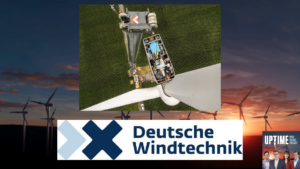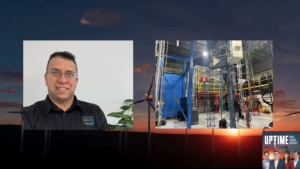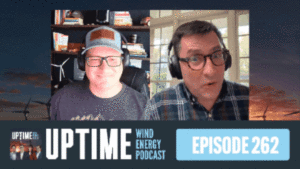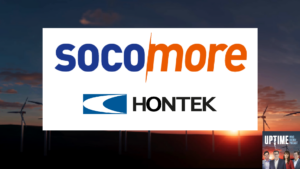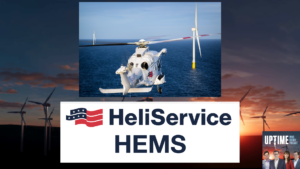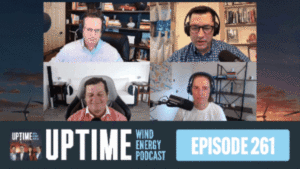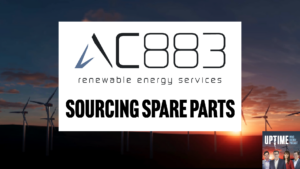Podcast: Play in new window | Download
Allen and Joel speak to Bryant Bertrand, CEO and co-founder of Ronin, to discuss their innovative power ascenders used in the wind industry. Ronin’s technology makes turbine climbs faster, safer, and less physically demanding for technicians, potentially transforming maintenance operations. Their products are designed with the technician in mind, from operation simplicity to weight.
Sign up now for Uptime Tech News, our weekly email update on all things wind technology. This episode is sponsored by Weather Guard Lightning Tech. Learn more about Weather Guard’s StrikeTape Wind Turbine LPS retrofit. Follow the show on Facebook, YouTube, Twitter, Linkedin and visit Weather Guard on the web. And subscribe to Rosemary Barnes’ YouTube channel here. Have a question we can answer on the show? Email us!
Pardalote Consulting – https://www.pardaloteconsulting.com
Weather Guard Lightning Tech – www.weatherguardwind.com
Intelstor – https://www.intelstor.com
Allen Hall: Welcome to the Uptime Wind Energy Podcast. I’m your host, Allen Hall, joined by my co host, Joel Saxum. Today, joining us is Bryant Bertrand, CEO and co founder of Ronin. And for those of you who haven’t encountered their equipment yet, Ronin is a company at the forefront of vertical access technology.
They develop power ascenders aiming to make turbine climbs faster, safer, and less physically demanding for technicians. In today’s episode, we’ll explore how Ronin’s ascenders are impacting maintenance operations from. Routine inspections to major component exchanges. And we’ll discuss the technology behind the devices, their safety features, and how they comply with industry standards.
. Will also share his insights on real world performance data and user experiences from wind farms across the country. So whether you’re a technician looking to optimize your climb times or an engineer interested in the latest maintenance tech or a site engineer considering ways to enhance your team’s efficiency, this conversation promises valuable insight.
Allen Hall: Welcome to the program.
Joel Saxum: Thanks for having me on guys. Bryant, give us a, give us the rundown. Give us the general thing here. What are you guys doing? What is the product?
Bryant Bertrand: Yeah. So let me give you just a little background on myself. My team, we came out of the rescue industry. Predominantly we were designing hoists and winches for helicopters.
So this is the mountainside Coast Guard rescue that you typically see on helicopters and believe it or not, there’s not rescues happening every day and a lot of times these birds get multipurpose into commercial activities and those activities may be dropping a technician off on a transmission tower, an offshore wind turbine, oil and gas platform, but we would just see a ton of access issues for men and women that are climbing in these at height industries.
And so we took a look saying how can we get some better access tools out there for these workers that are working on ropes. And we took a look at a lot of technology and specifically we looked at the military technology that was being deployed for power descenders. And you guys might have seen maybe videos of these devices coming out of the water SEAL teams or tactical teams doing on, off, offshore shipboarding with it.
And we said how do we take this technology which is. Very nichey, very military, very high, highly tech and make a more commercialized product that’s more looked like a tool. And that’s really. Where Ronan was founded on, and we’ve seen great success there and bringing these tools in these industries.
And they serve a number of great purposes in addressing access challenges and fatigue reduction and efficiency. And that’s really the core founding message of this business is to bring this technology to the forefront. And allow it to essentially elevate the workforce.
Allen Hall: So the key I’ve noticed from the Ronin technology is it’s pretty compact and I’ve seen old style ascenders and technicians out there with these things that look like they’re from the 1980s and they’re just these big, massive machines and they don’t move that well.
And I wonder about how safe they are. Ronan’s changed all that, right? Your stuff is clean.
Bryant Bertrand: So when you look at what we’re trying to do, with the Ronan product line, is we’re trying to have it very closely aligned with traditional fall protection equipment. And so when you talk about rope access, and you talk about people up and climbing, and the tools that they’re currently using, It’s an industry where maybe size you don’t want larger size.
You want smaller size, right? So you’re talking about workspaces. You’re talking about equipment in front of you and around you, stuff that you’re going to be positioning off. So size is really important. Really, when we took a look at the technology, we said, Hey, great technology. It’s out there. It’s a great access tool.
Nobody has access to it. And so it’s really about fundamentally looking at why don’t people have access to it? And one of the things is size. And ability to priced accordingly and training and ease of use and all those things that allow this to have better access within industry.
And so that’s really our core focus. And if you look at Ronan technology and where we’re always going to try to take it as our goal is to continue to get smaller, more affordable, better access, easier to use, easier to train, easier to roll out because, the biggest disservice we see right now with power to senders is.
Companies are looking at this technology to really extract the full benefits you can get out of it. You need to really look at rolling it out across your workforce. And to do that, you need to have technology that obviously is trainable, priced appropriately, small, compact and available. And so it’s really about breaking down those barriers of interest, entrance, getting more technicians able to have access to equipment because it is transformed for their lives and it’s transformed for the businesses that are using it.
Joel Saxum: I think something important here to touch on as well is you see this sometimes when innovative products come to the market, whether, it doesn’t matter what market or what industry it’s in, specifically here we’re in the wind industry, right? So when a product comes to market and you have to fight many fires to get it accepted within the product you’re not doing that as much, right?
You’re, rope access is definitely a thing. Working at heights is definitely a thing. Lifting kit is already a thing. These are things that people are doing in the industry day after day, but they’re doing it manually. Or they’re doing it in a less efficient manner. Like the one we had talked off air a little bit, one of the things we talked about was, say someone’s out doing a big blade repair, and this blade repair may be, most, as we as these blades get bigger, and the repairs get bigger, and the damages get bigger you’re not working on a, a one square foot area right in front of your face.
You’re working on a repair that might be a couple meters long. When you come down, and like I’m sailed down on the blade, and you start grinding, or you start prepping, or you start doing whatever, work task you need to do, a lot of times you need to go back up. So what happens then is you have to manually upsale yourself back up your rope.
And I’m not a rope access guy, so I can’t tell you exactly how to do that. But I do know that it’s a manual process, right? So you’re going to wear yourself out. You’re getting fatigued at the end of the day. Sometimes, and I don’t want to, you don’t want to see this, but at the end of the day, if it was like, you may see people cutting corners cause they’re man, I got to climb back up there.
But now it’s just the flip of a switch. You’re back up to the top of the repair.
Bryant Bertrand: Yeah. So really, when you talk about, in, in speaking to the wind industry, they’re going to use this device and a number of core functions, one will be personal ascension. When talking about blade repair, and the efficiency to be able to go back up and down that blade on inspection and repair, super important. So when you look at climbing from a rope standpoint on a synthetic rope, as you’re jogging or footlocking or manually trying to get yourself back up a lot of wear and tear on the body, a lot of soft tissue muscle damage, you’re actually inducing a lot of shock load on the body just in that core function.
That’s some of the stuff that wears our climbers out. And not only are they’re jogging up their weight, they’re jogging up their tools, their personal protective equipment. So you’re talking about your own body weight and typically 45 pounds on your body to move that. The power to center starts to.
eliminate those challenges. So not only are you going to get better body ergonomics, you’re going to get better efficiency when you’re doing that type of work out there on the blades. Subsequently, this device is also being used in rescue. So if you had a rescue situation where you needed to do a two man pickoff, this is a device where when minutes matter, you’re going to be able to get down and do that assist and get to that climber.
Many times, when you look at It, it injuries out there where there is a fall or there is suspension trauma times. What really matters, in that harness and that suspension state, it’s about 15 minutes to that body can go into cardiac arrest. So getting down there, relieving that pressure, taking that load off that individual and getting them down is extremely critical in that process.
So you’ll see it being used in a rescue capacity also for an injured person. And then the third area is. is material hauling. So when you talk about inside that turbine, getting material up and down that center, maybe on a pitch motor change out or anything in that nature, this is going to be your tool that maybe that chain hoist or that electric hoist on the inside isn’t working.
You have a difficult access point. Where a traditional fixed fixed hoist and winches are going to work well, you can be transitioning and using these ascenders. And from a material standpoint, that synthetic rope’s a lot easier medium to work off inside those turbines. So when you talk about a chain hoist or anything else and residents building up, that’s going to beat that infrastructure up, just wearing it out further, more maintenance.
So it’s a very portable, very flexible lifting tool. It’s going to offer a lot to the industry. In terms of access. So again, people, material, rescue. You’re getting a lot of application out of one device.
Allen Hall: So a lot of site managers are considering ascenders and it’s confusing looking out into the marketplace.
What should they be looking for in an ascender for their crews? I think we hit on that a little bit earlier,
Bryant Bertrand: When you’re looking at technology and typically, when the military has been purchasing ascenders for tactical operatives, they’re paying about 100, 000 in the center.
That’s just not something you’re going to sit and deploy out to every single journeyman that’s starting their career, but you’re not even, you’re not going to consider it. And when getting them this career technology or in their careers when it matters, right? That’s how you promote career longevity.
That’s how you promote retention in the industry. And number one thing is you got to get equipment that’s aligned price wise. And so something that you can roll out across your workforce. So a typical Ronin kit is going to start under 5, 000 for those kits. So it’s a little bit more closely aligned with what the cost would be outfitting your techs and traditional fall protection equipment, except it’s going to bring the Ascension portion to it, which is going to promote safety and efficiency that the rest of the person protective equipment.
Is not going to be able to provide. It’s just adding the body weight and the reaction response in case there is an injury. So you’re going to get, a benefit to this worker immediately right away at a price point that you can say now we’re going to build a program around this, right? We’re going to get this, we’re going to bring it in and something that we can get across our workforce.
Because if you just buy one or two of these and they’re sitting in the box, they’re not getting in the hands of crews, then you get no transformative benefits, right? You looked at the technology, right? You jumped into it, but you’re not really transforming your safety, your work environment, your efficiency.
So we’re really much aligned with treat this item as a tool, a standard tool, build the standards around it, build it across your organization, extract the benefits. And that’s really, the message that we’re trying to do different with the technology. Get it out of this niche realm of gadget and head it into straight tool, a tool, something you can hand a worker.
They can work with, it’s available, they know how to use it, and it’s there on site.
Joel Saxum: I think we’ve seen, in other kind of ascending tools, like a friend of the podcast 3S Lift. Their lifts have been fantastic for the morale, the fatigue, all the technicians love them to the point now where they’re just requesting them on site.
And that’s just the lift to get up in the turbine, right? And I’m not saying just because it’s a really important thing for those technicians. They love them. And so this, the Ronin Ascender, that’s the tool that is for everything else but that lift, right? Right there. Have the 3S lift inside, great for the technicians, you use the Roan and Ascender for everything else you do around the turbine to make sure that your guys are up and down.
But I think what that rolls into as well is, it becomes, you can become part of the training and safety culture part of it, right? So when we go and visit training centers around the country, we see 3S lifts right in the training center, and I think that’s a big part of what you guys are doing. You’re working with Spratt.
You guys are you’re right on with those guys.
Bryant Bertrand: Absolutely. Training is, the training is the key. And so the Ronin goes into a ton of industries, outside of just when you’re talking telecom, oil and gas, mining. Our retreat care and they’re all going to have different methods of work and different methods of access.
And so really what we try to do is work with the training houses to build certified programs around this technology that are industry specific that makes sense for that industry. So we’re always out there partnering with these training houses to develop these programs for early introduction into a technician’s career that makes sense for that specific industry.
The red. And what’s crazy about adhide industries is you see it, technicians may start in one industry and they traverse to another industry That’s a climbing industry, but maybe in a different market And you know with technology like this and the companies that invest into technology like this They’re going to be able to retrain those workers.
It’s not know, infrastructure is getting less complex and we’re not building more of it day in and day out and all infrastructure needs to be maintained. And these are difficult industries to recruit or train retain in, and really having this technology and recognizing its value to your efficiency and the worker is going to help you, retain the best, attract the best.
and keep the best as healthy as possible. And we need it. People want their power, people want their cell connection, people want their gas, people want everything that infrastructure provides. And it is me, primarily maintained by men and women up on ropes. Day in and day out to make sure
Allen Hall: this stuff
Bryant Bertrand: is working that
Allen Hall: we take for granted if you go to Ronin’s website Ronin power Ascender comm there’s a lot of good information there and Bryant I your website is really well laid out You can navigate it and understand what’s going on.
Bryant Bertrand: I appreciate that
And we try to do our best to lay it out in a very meaningful way where we have information so people can understand this because at the end of the day, this is new technology for many people. And so we’re here to help those businesses start that journey, start that education process.
We don’t expect, business to get into this and be power centers, experts, and where OSHA regulations. And. And what they need to do to be working properly within regulations. That’s where we come in. That’s where we’re here to help you on that journey of exploration, understanding implementation and use.
And that’s our jobs is a manufacturer not to just hand you product, but be there as a solution provider all the way through the process of adoption, especially with new technology.
Allen Hall: Is there a particular ascender that the wind industry technicians are clamoring for that you get a lot of requests for?
Bryant Bertrand: The newest, yeah, the newest ascender that we have is our Ronin TL ascender and that’s our smaller ascender. That’s one we’ve shrunk down in size. So that ascender, is roughly 18 pounds with the battery. And it’s going to be able to do single person ascension at 400 pounds, two person rescues at 600 pounds.
And material hauling up to 1600 pounds. So a lot of lifting power out of a very small, very light device. That’s unique, right? That’s a 1600 pounds is a lot of kit. That’s a lot of kit. That’s a lot of lift in, in for most stuff that’s going to handle a lot of the material lifting that you need, for, The type of work that they’re doing.
Allen Hall: Once I purchase a Ronin Ascender is what’s the typical maintenance on that piece of equipment? Am I sending it back to the factory or is there things that I’m doing myself to, to make sure it’s running properly?
Bryant Bertrand: So you have a couple options. And so when we certified our device, what we did is we did a a time based certification.
So we allow a business to take a device out of the box and use it as much as they want for a one year period. After that one year period, it needs to come back. For an inspection that can either come back to the facility or we can train the organization on how to do those inspections internally. It depends on the organization, what the program looks like, if they want that.
So they have a number of options. They can be internally doing that inspection or sending it in for that inspection. And the reason we did a time based certification is that takes the burden away from the operator to track usage. So on the device itself, they can pull it out. They can use it. If they’re using it daily as a winch or daily as a, an, as an ceer, they don’t need to track usage or rope footage on that.
Joel Saxum: I think that’s pretty standard in the industry anyways. Like a year, like of any PPE for climbing, whether it’s your har harnesses or ropes Yeah.
Bryant Bertrand: Most life safety. You want to take it back and do an inspection on it, on an annual basis. Yeah. It’s really critical. In terms of really making sure that.
Equipment and especially anything that you’re hanging on, is within that. And we do track that on the devices, every device is serialized and on the ID plate. We track that service acting as a calibration date, notifying when it needs to come back, when the next one’s due.
And so we try to make it very visual, for that operator to know when they pull a piece of equipment out, I’m using a piece of equipment that’s in service or outside of service.
Joel Saxum: Yes. In the wind industry, what has been the most uptake? Is it rope access repair people or where’s most of your sales come from?
Bryant Bertrand: We see it across the board. So I would say, 50 percent of our sender sales within wind are going for rope access and another 50 percent are going for material hauling. One thing to keep in mind with this type of technology in this commercial industry, And so in rescue, you’re allowed to ascend a person and lift material on the same equipment.
That’s how OSHA deems that acceptable. But as soon as you’re doing a commercial activity, you really need to dedicate ascenders for life safety and then ascenders for rigging. So they’re not going to let you mix and match. So you’re not going to be able to take an ascender that a person’s using for human ascension and then say, I’m going to take that same ascender and go, lift a pitch motor.
Technically you would be breaking A violation there in terms of rules and regulations on that. So that’s part of the education process we train So when we look at job sites or crews, it’s really about matching Two pieces of ascender one for human one for material so that they have both those options And that’s where again pricing affordably makes a heck of a lot of sense because if you’re going to have multiple functions going on and you want to stay within regulatory bounds and get all the capabilities.
You’re going to need to have equipment and we do a lot of things to help I. D. That we have different color coding options that we offer to to businesses so they can see, Hey, here’s my Ascender show winching. Here’s my one for human, we call out different nomenclature on the ID plates from.
Which in standards as opposed to human standards. So there’s different visual IDQs that we do to help separate that technology, make it sense for the industry.
Allen Hall: I want to go back to the website for a minute because it’s really good. And one of the things that also I noticed is on the safety portion of the website, you have a sort of training videos, which are on YouTube, but they’re in English and Spanish.
Super helpful.
Bryant Bertrand: Yeah, we’re trying to expand all the different languages. The Ronin goes worldwide and we started shipping these devices in 2018 and we’ve got about 5, 000 of them now out in the field in various countries. And this thing is touched and been shipped into about 40 different countries already.
So we see worldwide use with the product at height work, it’s not just a us challenge. It’s a world, it’s a worldwide challenge. And, essentially people are really starting to recognize the technology and starting to bring it in at a large level, and that’s great for the industry.
That’s where we want to see it. We want to continue to develop best practices and all these industries help develop better standards technology that makes sense. And so we’re continuing to see that. And, if you look the long term, If you look at the long term vision of where this product’s at, when you look at the things and how regulations come about, typically, most of the time regulations don’t start at the top and then flow their way to the bottom.
It really starts at industries developing best practices. Those best practices then become standards. Those standards get evaluated for goodness and regulation comes in. This is what we’re going to do, and eventually you’ll see that with power to sender technology. There’s no other piece of personal protective equipment that I can present to you that’s going to do this much for fatigue and ergonomics stress.
And if you take any look at NSE data, the top running issues right now that have been a number of years over, over exertion and fatigue, right? That’s a claim area that continues to rise. across all industries. It’s a reality. We’re working harder than ever before to maintain this infrastructure.
And there’s very little tools I can present to you that’s going to really address that fatigue aspect, especially for climbers. And most of the stuff, time when you look at a climber, you’re just adding weight to their body. You’re adding personal protective equipment. That’s going to hopefully keep them safe from an injury, but it doesn’t have a lot of proactive preventiveness against something like fatigue, so it compounds it.
And if you look at fall data and most fall data, you can see how fatigue and falls are very much coming together. If you look at most data out there and statistically, most falls are happening at the end of the day. Why are they happening at the end of day? That’s when the technicians most tired. That’s when they make the mistake.
That’s when the accident happens. So we’re trying to bring this technology in as a way to say, Hey, this may possibly have a great, proactive, preventative approach lowering the two areas of claims that we continue to see rise year and year after year. So if you are a business and you are an environmental health and safety person or safety person within your organization, and you’re not looking at this technology, I strongly suggest.
to spend some time to really understand it. It will transform your safety in a way that no other piece of equipment can right now.
Allen Hall: Absolutely. And Bryant, how do people get a hold of you to order a Ronin Ascender?
Bryant Bertrand: Obviously, they can go to the website, RoninPowerDescenders. com. You can, there’s a number on there where you can call in.
We’re readily available and reachable. You can also find me on LinkedIn. Just hit Bryant Bertrand, LinkedIn. Ronan and you’ll find me there. You can ping me there. You can reach me on my email, which is bbertran at ronanascenders. com and reach out. I’m interested in talking to you, interested in how we can start to work with you, how we can get out there, demo with you.
If you’re a training house and you’re interested to build a certification or training program around this, we’re interested in talking to you. We’re all about working with industry right now to help bring this technology up, elevate our workers. It’s the biggest. It’s the biggest disservice of any climbing of all climbing industries because you see it across the board These technicians start at the top but work their way to the bottom and we’re trying to change that right now Keep them doing what they love out there up there and healthy.
Allen Hall: Amen. So if you’re interested in ronin power centers head to the website Or contact Bryant. Bryant, thank you so much for being on the podcast. This has been a really interesting discussion.
Bryant Bertrand: Guys. I appreciate it. Thank you. We’re here. If the guys, if your listeners have any other questions or follow up, they can just reach out and we’re here to help.




